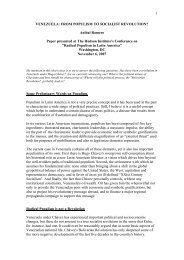NEW PLAYERS IN THE MEDITERRANEAN - German Marshall ...
NEW PLAYERS IN THE MEDITERRANEAN - German Marshall ...
NEW PLAYERS IN THE MEDITERRANEAN - German Marshall ...
Create successful ePaper yourself
Turn your PDF publications into a flip-book with our unique Google optimized e-Paper software.
providing facilities needed by the Russian navy. The<br />
country on which Moscow has focused most intently<br />
in its quest to re-establish a Mediterranean flotilla<br />
is Syria, which made its ports of Tartus and Latakia<br />
available to the Soviet navy in exchange for economic<br />
assistance, political support, and arms sales. As with<br />
Russian weapons sales to Syria, the Kremlin must<br />
now calibrate its overall support for Damascus so<br />
as not to damage its relationship with Israel. So it<br />
cannot provide all that Syria seeks in exchange for<br />
providing the Russian navy access to its ports. At<br />
the same time, Russia realizes that, unlike, Algeria,<br />
Egypt, and Libya, Syria’s options are more limited and<br />
that it will have to turn to Russia for its armament<br />
needs. This asymmetric dependence has enabled<br />
Russia to persuade Syria to allow it to modernize and<br />
expand the ports of Tartus and Latakia so that they<br />
can support the Russian navy’s deployments in the<br />
Mediterranean. 31 The Kremlin sees the former as the<br />
pivotal facility for its Mediterranean naval contingent<br />
and has been dredging it and establishing the<br />
infrastructure required to support Russian warships.<br />
Russian naval officers are understandably tightlipped<br />
and acknowledge the costs in establishing and<br />
operating other naval facilities in the Mediterranean.<br />
Looking ahead, Algeria and Libya, given their<br />
locations in the Mediterranean and their significant<br />
purchases of Russian weaponry, are likely to be where<br />
Russia seeks addition facilities. Access for the Russian<br />
navy to Benghazi port was said to be among the issues<br />
discussed during Qadhafi’s 2008 visit to Moscow. 32<br />
31<br />
“Russian Mediterranean Warships Placed Under Black Sea<br />
Fleet Command,” Debka.com, August 29, 2008, at http://www.<br />
debka.com/article/7819/; “Russian Navy Eyes Tartous, Syria<br />
[sic.] as Base for Black Sea Fleet,” WorldTribune.com, January<br />
13, 2009, at http://www.worldtribune.com/worldtribune/<br />
WTARC/2009/me_syria0035_01_13.asp.<br />
32<br />
“Russian Navy Plans Bases in Syria, Libya, Yemen, Welt Online,<br />
January 16, 2009, at http://www.welt.de/english-news/article3039085/<br />
Russia-plans-navy-bases-in-Syria-Libyia-Yemen.html; Hugh<br />
McLeod, “From Syrian Fishing Port to Naval Power Base: Russian<br />
Moves in the Mediterranean,” Guardian, October 8, 2008.<br />
Even before additional facilities have been acquired,<br />
Russia has made its ambition for a permanent<br />
naval presence clear. Russian naval officers have<br />
said that Tartus will be the main support base for<br />
the Mediterranean naval contingent and that it, in<br />
turn, will come under the operational command of<br />
the Black Sea Fleet based at Sevastopol in Ukraine’s<br />
Crimean peninsula. And in 2007, after conducting<br />
exercises with the Turkish navy, a Russian task<br />
force from the Northern Fleet led by the Admiral<br />
Kuznetsov (which Russia defines as a “heavy<br />
aircraft-carrying cruiser” and Western observers<br />
describe as an aircraft carrier) linked up with ships<br />
led by the Black Sea Fleet’s flagship, the Moskva,<br />
at Tartus for a two-week exercise. In addition<br />
to the Kuznetsov and Moskva, the operation<br />
involved destroyers (the Admiral Chabanenko and<br />
Admiral Levchenko), TU-95MS (Bear), TU-22M3<br />
(Backfire-C), A-50 (Mainstay) early-warning<br />
surveillance aircraft, IL-78 (Midas) refueling<br />
tankers, and MiG-31 (Foxhound), and SU-27<br />
(Flanker) fighters. 33<br />
These developments notwithstanding, it is<br />
important to keep Russia’s naval deployments and<br />
exercises in the Mediterranean in perspective.<br />
To begin with, the Russian navy is a shadow of<br />
its former self and has yet to recover from the<br />
economic collapse Russia suffered in the 1990s.<br />
Russia’s defense budget is about one-tenth the size<br />
of the United States,’ and there is no prospect of<br />
a significant number of ships, submarines, naval<br />
aircraft, and support vessels being added to the<br />
navy to give it the kind of muscle and capacity<br />
for power projection that Russian leaders may, in<br />
the abstract, want it to have. The naval balance<br />
in the Mediterranean overwhelmingly favors<br />
the United States and its NATO allies, and there<br />
33<br />
Details from Stratfor.com, December 17, 2007, “Russia Plans<br />
Buildup,” and “Russia: A Major Mediterranean Deployment,” at<br />
http://www.stratfor.com/analysis/russia_major_mediterranean_<br />
deployment.<br />
New Players in the Mediterranean 17
















